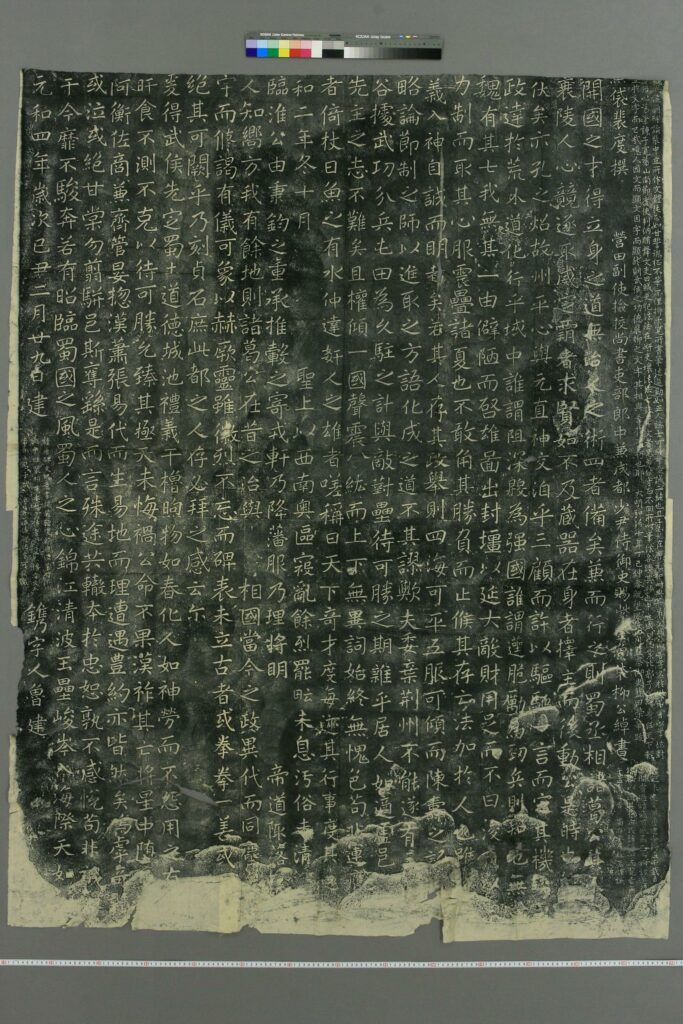- 2023年-12月-31日:汉鲁相韩敕造孔庙礼器碑(51P)
- 2023年-12月-31日:横文字運筆自在.吉田庸徳著(17P)
- 2023年-12月-31日:柳公权楷书玄秘塔碑(50P)
- 2023年-12月-31日:赵孟頫心经墨迹.赵孟頫书(4P)
- 2023年-10月-29日:颜真卿书法全集·中国十大书法家墨宝全集(135P)
- 2023年-10月-29日:赵孟頫书法全集·中国十大书法家墨宝全集(143P)
- 2023年-10月-29日:欧阳询书法全集·中国十大书法家墨宝全集(137P)
- 2023年-10月-29日:苏轼书法全集·中国十大书法家墨宝全集(153P)
- 2023年-10月-29日:米芾书法全集·中国十大书法家墨宝全集(152P)
- 2023年-10月-29日:柳公权书法全集·中国十大书法家墨宝全集(144P)
- 2023年-10月-29日:黄庭坚书法全集·中国十大书法家墨宝全集(146P)
- 2023年-10月-29日:怀素书法全集·中国十大书法家墨宝全集(111P)
- 2023年-10月-29日:董其昌书法全集·中国十大书法家墨宝全集(144P)
- 2023年-09月-09日:魏齐周隋唐造像铭等拓本集.方伯裕题签(71P)
- 2023年-09月-09日:拟山园帖.10卷.王铎书.王无咎集.吕昌摹.张翱镌.清顺治16年拓本(292P)
- 2023年-08月-26日:中国楷书名贴精华(三)(525P)
- 2023年-08月-26日:中国楷书名贴精华(二)(557P)
- 2023年-08月-26日:中国楷书名贴精华(一)(589P)
- 2023年-08月-26日:中国行书名贴精华(二)(612P)
- 2023年-08月-26日:中国行书名贴精华(一)(620P)
- 2023年-08月-26日:中国魏碑名贴精华(551P)
- 2023年-08月-26日:中国隶书名贴精华(586P)
- 2023年-08月-11日:中国篆书名贴精华(549P)
- 2023年-08月-11日:中国草书名贴精华(三)(584P)
- 2023年-08月-11日:中国草书名贴精华(二)(581P)
- 2023年-08月-11日:中国草书名贴精华(一)(567P)
- 2023年-06月-14日:苏轼一生的书法(41P)
- 2023年-05月-21日:鉴识古印[中国古玩鉴识系列](83P)
- 2023年-03月-25日:淳化閣帖(303P)
- 2023年-03月-24日:王羲之书法全集(501P)
- 2023年-03月-20日:十七帖.王羲之書(27P)
- 2023年-03月-20日:孙过庭草书千字文(28P)
- 2023年-03月-20日:秋兴八首.杜甫诗.怀素书(28P)
- 2023年-03月-20日:杭州福神观记.邓文原撰.赵孟頫书.吴荣光题跋.民国拓本(32P)
- 2023年-03月-15日:赤壁怀古.苏轼词.黄庭坚草书(13P)
- 2023年-03月-09日:小竹斎千字文.乾坤.小竹老人書(70P)
- 2023年-03月-09日:玉照堂遺愛字紙.上下.著作堂主人觧集(36P)
- 2023年-02月-26日:趙子昴真書九十二法(14P)
- 2023年-02月-15日:历代钟鼎彝器款识法帖.20卷.宋薛尚功撰.民国24年.海城于氏景印明崇祯朱氏刻本(260P)
- 2023年-02月-14日:豊道生篆書奇文四字經(17P)
- 2023年-02月-14日:黄忠端小楷孝经(22P)
- 2023年-02月-14日:李陽冰三墳碑(23P)
- 2023年-02月-14日:快雪堂法書(74P)
- 2023年-02月-14日:九成宮醴泉銘.魏徴撰.欧陽詢書(31P)
- 2023年-02月-13日:春夜宴桃李园序.文徴明书(19P)
- 2023年-02月-13日:古今印则.四卷程远摹选.项梦原校.明万历(69P)
- 2023年-02月-09日:真書千字文.巌谷修書(72P)
- 2023年-02月-09日:真草千字文.赵孟頫(26P)
- 2023年-02月-07日:饮中八仙歌.明祝允明書(16P)
- 2023年-02月-06日:孫氏養正楼印存.百福.百禄.百寿印(323P)
- 2023年-02月-04日:日本神字考.上下卷.沈文荧译.园田弘编.1884年(63P)
- 2023年-02月-03日:蜀山图歌.赵孟頫书.清那彦成集(4P)
- 2023年-01月-30日:蜀丞相諸葛武侯祠堂碑.裴度.撰(2P)
- 2023年-01月-28日:前赤壁赋.苏轼撰.民国拓本(38P)
- 2023年-01月-25日:小楷大学.赵孟頫(15P)
- 2023年-01月-24日:王阳明行书太极图说.宋周敦颐撰.明王阳明书.清末填墨本(75P)
- 2023年-01月-23日:吴氏印谱.吴睿.万历茅一相刻.欣赏编本(120P)
- 2023年-01月-17日:古印屏風(21P)
- 2023年-01月-13日:宋画华谱(24P)
- 2023年-01月-12日:唐国师千福寺多宝塔院故法华楚金禅师碑(22P)
- 2023年-01月-10日:名臣法帖.第1-10(233P)
- 2023年-01月-03日:吉金斋古铜印谱.六卷.何昆玉辑.吴大澂鉴定(340P)
- 2023年-01月-01日:金石图.四册.牛运震编.褚峻摹.清乾隆十年刊(148P)
- 2023年-01月-01日:龙门造像铭.拓本(40P)
- 2022年-12月-30日:集古草诀辨疑(81P)
- 2022年-12月-30日:英文书法的艺术.Art.Of.Calligraphy(128P)
- 2022年-12月-26日:筆鋒本原(46P)
- 2022年-12月-23日:历代圣贤篆书百体千文(60P)
- 2022年-12月-20日:中国传世书法(172P)
- 2022年-12月-18日:兰亭序(324P)
- 2022年-11月-20日:篆书·认识书法艺术(133P)
- 2022年-11月-20日:篆刻·认识书法艺术(111P)
- 2022年-11月-20日:行书·认识书法艺术(103P)
- 2022年-11月-20日:隶书·认识书法艺术(117P)
- 2022年-11月-20日:楷书·认识书法艺术(129P)
- 2022年-11月-06日:元代书法(281P)
- 2022年-11月-04日:宋代书法(261P)
- 2022年-11月-02日:清代书法(277P)
- 2022年-11月-01日:名碑十品(308P)
- 2022年-09月-29日:元周伯琦篆书宫学国史二箴(28P)
- 2022年-09月-29日:元拓张从申茅山玄静碑(30P)
- 2022年-09月-29日:宋拓司隶校尉鲁峻碑(40P)
- 2022年-09月-29日:宋林逋行书自书诗并苏轼行书和诗(33P)
- 2022年-09月-29日:晋王羲之王献之小楷书选(35P)
- 2022年-06月-12日:篆刻艺术欣赏(29P)
- 2022年-06月-09日:“篆刻”印模若干系列(10P)
- 2022年-06月-04日:中国印欣赏(31P)
- 2022年-05月-20日:滕王阁序印谱(29P)
- 2022年-05月-20日:乾隆宝薮(完整版)(32P)
- 2022年-05月-20日:汉代私印三百多方(46P)
- 2022年-05月-15日:宿悦书《道德经》(56P)
- 2022年-04月-26日:清代书法赏析(36P)
- 2022年-04月-26日:明代书法赏析(57P)
- 2022年-04月-26日:元代书法赏析(36P)
- 2022年-04月-26日:宋代书法赏析(49P)
- 2022年-04月-26日:隋唐五代书法赏析(50P)
- 2022年-04月-26日:汉魏晋南北朝书法赏析(36P)
《蜀丞相诸葛武侯祠堂碑》,唐宪宗元和四年(公元809年)立。碑身及碑帽通高367cm、宽95cm、厚25cm,下有碑座。碑帽的云纹雕饰,具有唐代石刻艺术特点。记者细数碑文共24行,每行约50字。碑文为楷书竖行,有1094字,由曾任监察御史、宰相的裴度所撰,由曾任吏部尚书、兵部尚书,又是著名书法家柳公权之兄的柳公绰所书,当时蜀中名匠鲁建所刻。文章、书法、刻工均为难得精品,所以后人称它为“三绝碑”。碑文内容分序文和铭文,碑文对诸葛亮短暂而悲壮的一生作了重点褒评,竭力赞颂诸葛亮的高风亮节,文治武功,并以此激励唐代的执政者。元和二年(公元807年)成都动乱,唐王朝派相国武元衡出任剑南四川节度使。裴度当时与柳公绰一起在西川节度使武元衡手下任节度判官,裴、柳关系密切,又都敬慕诸葛武侯,遂一文一书,共同写就了中国书法史上的不朽杰作。古人制作石碑有两种方法,一种是书家直接在石碑上创作,由刻工篆刻完成;另一种是摹勒上石,是将文字写在纸上,再在纸背以朱砂等依样勾勒字的轮廓,然后覆于备刻的石头或木头上进行篆刻。“经过考证,当时柳公绰应该是以书丹上石方式,用毛笔直接在石头上写字以备镌刻。他说,丹就是指朱砂。那时制作碑刻都是用朱砂,朱砂是颗粒状,比粉状的墨稳定性强,写在光滑的石上不流、不走样。墨含有油分,遇石收缩,不能保持笔触的原形。另外,碑石一般是灰色或青色,朱砂痕迹明显,便于走刀。杨代欣用手做成握毛笔状,在石碑上演示着说道,当时柳公绰或是站着,或是将石碑放倒,趴在石碑上一气呵成完成了这件作品。石碑上应该是打有暗格,经过长时间风化,如今暗格已辨不清了。制作“三绝碑”的石料也非成都本地石材,而是来自西安的南田石。三绝碑”是成都年代最久远的地面文物。这块石碑历来都被作为重要文物进行保护,《书林藻鉴》曾引评家评此碑的书法:“公绰武侯祠记,如端人正士,笔法遒劲。”明王世贞也说柳公绰“其行笔飘洒雄逸,无拘迫寒窘之态”。宋代大书法家米芾曾说“公绰乃不俗于兄”,对柳公绰书法给予了高度评价。
The Monument to the Ancestral Hall of Zhuge Wu, the prime minister of Shu, was established in the fourth year of Yuanhe (809 A.D.) of Xianzong of Tang Dynasty. The body and cap of the tablet are 367cm high, 95cm wide and 25cm thick, and there is a tablet seat below. The cloud carving of the stele cap has the artistic characteristics of stone carving in the Tang Dynasty. The reporter counted the inscription in 24 lines, each of which was about 50 words. The inscription is in regular script and has 1094 characters. It was written by Pei Du, who was once the chief inspector and prime minister, and by Liu Gongchuo, who was the minister of the Ministry of Civil Affairs and the minister of the Ministry of Military Affairs, and the brother of the famous calligrapher Liu Gongquan. It was carved by Lu Jian, a famous craftsman in Shu at that time. Articles, calligraphy and carving are rare works, so later generations call them “three unique monuments”. The content of the inscription is divided into preface and inscription. The inscription made a key comment on Zhuge Liang’s short and solemn life, and tried to praise Zhuge Liang’s lofty demeanor, political integrity and martial arts, and thus inspired the rulers of the Tang Dynasty. In the second year of Yuanhe (AD 807), Chengdu was in turmoil. The Tang Dynasty sent Wu Yuanheng, the prime minister, to serve as the governor of Jiannan Sichuan. At that time, Pei Du and Liu Gongchuo served as a judge of Jiedu under Wu Yuanheng, the Jiedu envoy in Xichuan. Pei and Liu were closely related and both admired Zhuge Wuhou, so they wrote an immortal masterpiece in the history of Chinese calligraphy. There are two ways for the ancients to make stone tablets. One is that the calligrapher creates directly on the stone tablet, which is completed by the carver; The other is to copy the stone, which is to write the characters on the paper, then outline the characters on the back of the paper with cinnabar and other patterns, and then cover them on the stone or wood to be carved for seal cutting. “After textual research, Liu Gongchuo should have written directly on the stone with a brush in the form of calligraphy and stone for engraving. He said that Dan means cinnabar. At that time, all the steles were made of cinnabar. The cinnabar is granular, which is more stable than the powdery ink. The ink does not flow or go out of shape when written on the smooth stone. The ink contains oil, shrinks when it meets the stone, and cannot maintain the original shape of the strokes. In addition, the steles are generally gray or cyan, and the cinnabar traces are obvious, It is convenient for cutting. Yang Daixin made a brush with his hand and demonstrated on the stone tablet that Liu Gongchuo either stood or put the stone tablet down, lying on the stone tablet and finished the work at one go. The stone tablet should have a dark grid. After a long time of weathering, the dark grid is now indistinct. The stone used to make the “Three Unique Steles” is not local stone in Chengdu, but Nantian stone from Xi’an. The “three unique monuments” are the oldest ground cultural relics in Chengdu. This stone tablet has always been protected as an important cultural relic. “Shulin Zaojian” once quoted critics to comment on the calligraphy of this tablet: “Gongchuo’s memorial of the marquis of Wu, such as a decent man, has strong strokes.” Wang Shizhen of the Ming Dynasty also said that Liu Gongchuo “has elegant and elegant strokes, and is not constrained to be embarrassed by cold.”. Mi Fu, a great calligrapher of the Song Dynasty, once said that “Gongchuo is not inferior to his brother”, and highly praised Liu Gongchuo’s calligraphy.


Art艺术 Calligraphy书法 2P 蜀丞相諸葛武侯祠堂碑.裴度.撰
历史上的今天 ( 33 ):
- 2024年-01月-30日:Super Nintendo:Pachio - kun Special 3 柏青哥君-特别版3
- 2024年-01月-30日:Super Nintendo:Pachio - kun Special 2 柏青哥君-特别版2
- 2024年-01月-30日:Super Nintendo:Pachio - kun Special 柏青哥君-特别版
- 2024年-01月-30日:Super Nintendo:Pachinko Wars 2 柏青哥大作战2
- 2024年-01月-30日:Super Nintendo:Pachinko Wars 柏青哥大战
- 2024年-01月-30日:Super Nintendo:Pachi-Slot Love Story 柏青嫂:爱的故事
- 2024年-01月-30日:Super Nintendo:Pachi-Slot Land: Pachi Pachi Coin no Densetsu 柏青嫂乐园:许愿硬币传说
- 2024年-01月-30日:Super Nintendo:Pachi-Slot Kenkyuu 柏青嫂研究
- 2024年-01月-30日:Super Nintendo:Pachi-Slot Kanzen Kouryaku 柏青嫂完全攻略:Universal新进机台Volume1
- 2024年-01月-30日:Super Nintendo:Pachi-Slot Gambler 柏青嫂胜负师
- 2024年-01月-30日:Video视频:雪地里,发春的骏马
- 2024年-01月-30日:Video视频:有些人啤酒是用来舔的
- 2024年-01月-30日:Video视频:公司前台,又下班了
- 2024年-01月-30日:Video视频:衣服都扣不上的胸部
- 2024年-01月-30日:Video视频:老百姓,为了生活,衣不蔽体
- 2024年-01月-30日:Video视频:两个人类优质,在宾馆约会
- 2024年-01月-30日:Video视频:拍戏而已,别假戏真做
- 2024年-01月-30日:Video视频:现在的男人都这么清秀了?
- 2024年-01月-30日:Video视频:是得跟所有小三告别了
- 2024年-01月-30日:Video视频:为什么,现在女生都很污
- 2024年-01月-30日:Video视频:每个夜场女,都很会跳舞
- 2024年-01月-30日:Video视频:这么多胖黑美女,喜欢哪个?
- 2024年-01月-30日:Video视频:伟大是言辞,点赞支持
- 2024年-01月-30日:Video视频:生育率太低,只因不懂繁殖
- 2024年-01月-30日:Video视频:按个摩还调戏小姑娘了,无耻
- 2024年-01月-30日:Video视频:很清凉大冬天的夜场
- 2024年-01月-30日:Video视频:房事后感想,女性越老越想要
- 2024年-01月-30日:Video视频:娶老婆,送小孩
- 2024年-01月-30日:Video视频:好身材倒立也很好看
- 2024年-01月-30日:Video视频:夜场跳舞都这么开放了?
- 2024年-01月-30日:Memory记忆:China in 1945 under the lens of American Life Magazine 美国生活杂志镜头下1945年的中国 (77P)
- 2024年-01月-30日:Memory记忆:Other old photos from China 中国其他老照片 (8P)
- 2024年-01月-30日:News新闻:2024年1月30日新闻简报(国内国际)
可点 ➠ 2023年-01月-30日 ➠ 36 s ➠ ♥ 0

